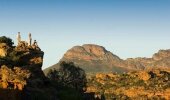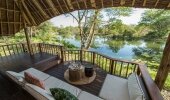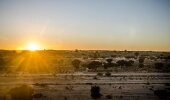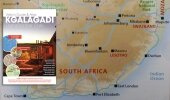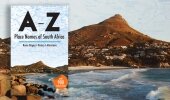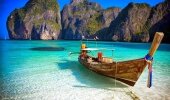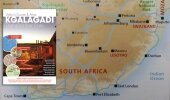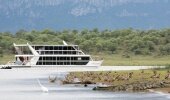Words & photos by Xen & Adri Ludick
Leaving Central Kalahari, we were now some 1,530km into our 7,200km journey after being on the road for six days. It had been an incredible adventure so far and we were looking forward to the delights and sights we would come across as we leisurely picked our way to the Okavango.
Rakops was next on the radar and we made our way there on a 45km twee-spoor road. You can obtain fuel here, if it’s available. From here, we travelled on a good tar road via Motopi to Maun, the self-proclaimed gateway to the Okavango Delta and fifth largest town in Botswana. Once a rough-and-tumble outpost for grazers, hunters and poachers, a burgeoning safari industry now drives the town’s economy. The area had recently received a lot of rain and despite being warned about the floods, we decided to take a chance and keep going – Africa is not for sissies, right! Arriving at Toteng, a small town that is said to be the location of the oldest ‘directly dated evidence of cattle in southern Africa’, we encountered our first flooded bridge and had to take a detour through another village. I have to admit that I love detours because it gives you the opportunity to see different rural villages, its people and interesting sights along the way that you otherwise would have missed.
Turning north at Sehithwa, we followed the road along the western side of the Okavango Delta, the world's largest inland delta. When crossing the border at Mohembo, we were totally baffled by the skeptical looks we received from the locals when we mentioned that we were on our way to Ngepi. Feeling a bit unsettled, we stopped to ask a cattle herder if we could proceed and he assured us that it was safe. As we approached Ngepi, and to our great surprise, all we could see was one huge mass of water! Ngepi was completely flooded. It was quite a sight! Leaving this watery wonderland behind us, we headed toward Popa Falls Resort and were fortunate to secure the only campsite where the braai was not swimming in water. About 20m from where we camped was a stream, with a little bridge crossing over it and a path that led to the Popa Falls, which is surrounded by enchantingly beautiful and ever-green vegetation. However, with the flooding, the bridge was about five centimetres below the water, but proved to be an ideal place for Xen to do some fishing from. His efforts were rewarded with a beautiful, full-grown tiger fish. The next evening, just before sunset, Xen decided to try his luck again. Standing right behind him on the bridge, he was unable to hear a thing I was saying because of the rumbling of the water, and so we decided to pack up and return to the campsite. Just as we sat down, we saw a huge crocodile resting in the exact spot where we had stood less than five minutes earlier. We couldn’t believe our eyes, our thoughts turning to what could have been a nasty experience. That evening, safely ensconced in our roof tent, we watched hippo grazing all around us and could actually see the shiny back of a hippo that stood next to the tent’s ladder, it was so close. It was another magical experience that would remain forever in our memories.
Bidding farewell to the crocodile and hippo, our next destination was the 384,000ha Khaudum National Park, which was unknown to us and we couldn’t wait to discover and explore this new playground.
About 60km from Bagani we turned south to Khaudum, and although we had heard many stories about the thick sand in the area, we didn’t expect it less than 50m from the tar road. We immediately got out and deflated the wheels to 1.5 bars. Having travelled in thick sand countless times before, we immediately realised that this thick sand was different. It took about three intense hours to travel the 59km to Khaudum camp.
The car ran hot and Xen switched on the warm air in the car to help cool the engine. It was not until we stopped at Khaudum that we realised we were suffering from heat exhaustion. Whilst cooling down the engine of the car, we hadn’t thought to look after our own bodies. We guzzled down as much liquid as possible, then ate a good meal and slept for about an hour. Feeling a lot better, we decided to explore the area and took a drive along the riverbed, where we saw the most beautiful roan antelope, ostriches, blue wildebeest and kudu. The roads are not in good condition and the elephant grass in some places made any sightings impossible. However, the variety of ‘life’ found on our bonnet and windscreen was quite amazing. There was worms, wasps, moths, butterflies, beetles, spiders, stick insects, different kinds of locusts, butterflies and many more. Again we asked ourselves how people can say that they saw ‘nothing’, when you will always see something if you look close enough.
The offices and campsites at the Khaudum and Sikereti Camps are not in a good state and it’s evident that not many people visit this part of Namibia. It was also clear that the elephants didn’t have any respect for Khaudum or its facilities, however the views are indescribably beautiful. The riverbeds are lush and green, and the vegetation changes from deep sand to long elephant grass and the most beautiful Kalahari trees. Our campsite was on a little hill overlooking the flats and riverbed and we could see many animals grazing. Later that night, we relaxed under a bright full moon and listened to the haunting sounds of hyenas close by.
The next day we meandered along the Omuramba riverbed to the Leeu Pan and then turned north again past the Tau Pan and finally south to the Dussi waterhole. After Dussi the road to Sikereti is good and easy to travel on. Along the way, we saw two huge restless elephants and the game warden at Sikereti couldn’t believe it as, according to him, the elephants only migrate from Botswana later in the year. When we enquired about staying over at the camp and wanted to pay for our accommodation, we couldn’t understand why he wouldn’t take our money. But when we reached what was supposed to be the ‘campsite’, we totally understood. The place looked like a Hill Billy’s residence; a few old and dilapidated wooden bungalows inhabited only by some ground squirrels. There was cold running water, but the taps and floor were covered in yellowish, crystallized calcium formations and all the structures were in desperate need of repair. There were broken cisterns and piles of long-forgotten rubble scattered everywhere. Having assessed our abode for the night, we decided to lift our sombre mood by taking a game drive to the Tsoana waterhole in search of something more visually pleasing. We came across a huge herd of elephants grazing close to the road. Stopping to take photographs, our shoot was interrupted when a bull, at the top of the hill, made a suppressed rumbling noise. The next moment a young bull stormed us, but we thought that it was just a mock charge. However, when he did not stop his speedy approach Xen slammed the car into drive and drove off at a pace that left the young bull eating our dust. In the book ‘The Elephant Whisperer’, Lawrence Anthony, the author, describes the young warrior Frankie as always ready to see off any threat. When the elephant finally decided to give up the chase after about 100m, I immediately baptized him Frankie. Our next dilemma was getting back to camp, as there was only way back – and that was past young Frankie and his family. I can’t recall ever having prayed so hard, and for good measure I also repented all my sins, as we approached the battle zone. Thankfully, the herd had moved on and my sense of relief was huge, as was my thanks to God.
Happy to be back at the ‘campsite’ I took a quick shower before dark, with Xen keeping a watchful eye. After such an eventful day, the calmness of the full moon and a good whiskey was all the excitement we needed for the rest of the evening.
Leaving early the next morning, we made our way to Tsumkwe on a good road. Unfortunately we got so caught up in reliving the experiences of the previous day that we forgot to visit the well-known baobab, the Dorstlandboom. This was the place where the Thirstland Trekkers camped in 1892 during their journey from the Transvaal to Angola – and was another good reason for us to return. Getting back to the elephants, we racked our brains for reasons why the elephant had charged us. I thought that it could have been because my flash went off, but later we read that these migrating elephants have been shot at by hunters and now associate people with death. No wonder they chased us so fiercely!
In the next issue of DO IT NOW we make our way to Etosha, with its own beauty, hordes of tourists and more exciting tales that I look forward to sharing with you.
